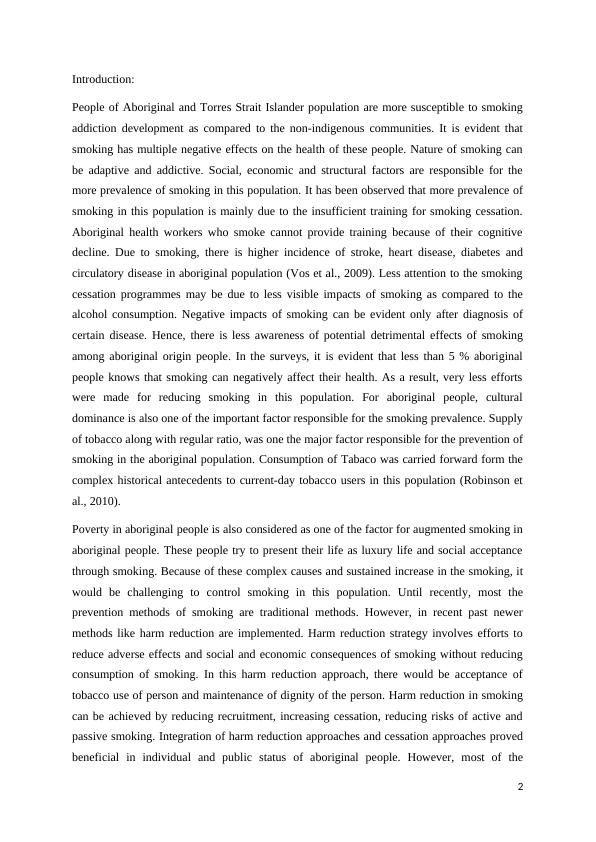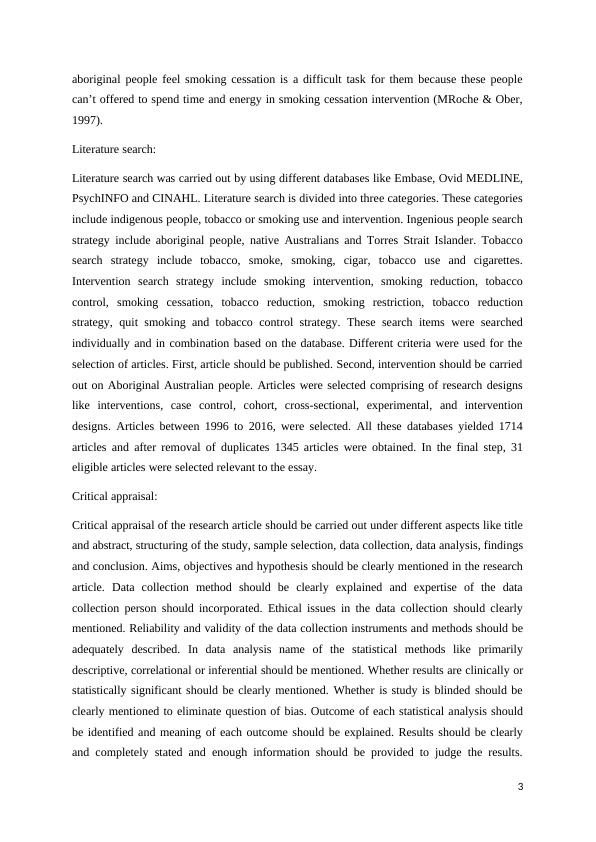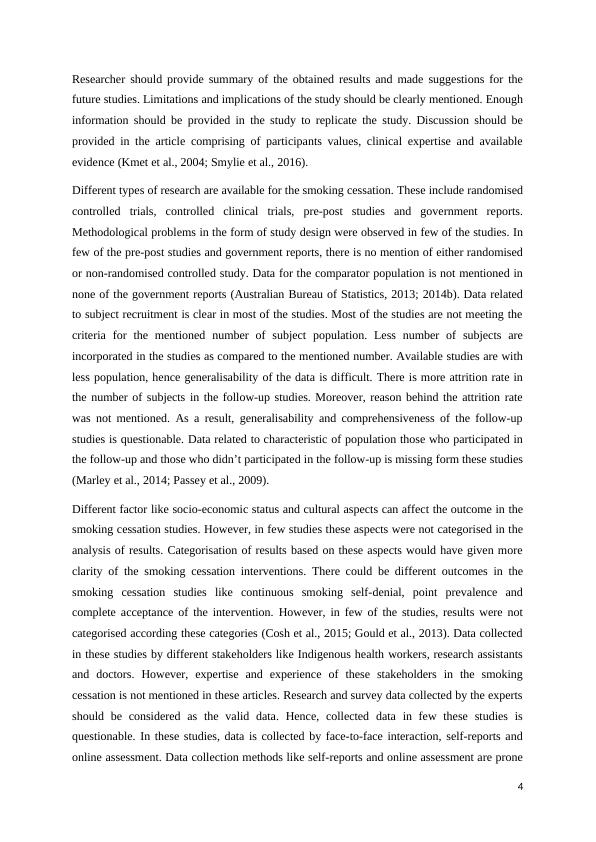Research Literacy for Health Practice
Added on 2020-04-01
12 Pages4031 Words175 Views
Research Literacy for Health Practice1

Introduction:People of Aboriginal and Torres Strait Islander population are more susceptible to smokingaddiction development as compared to the non-indigenous communities. It is evident thatsmoking has multiple negative effects on the health of these people. Nature of smoking canbe adaptive and addictive. Social, economic and structural factors are responsible for themore prevalence of smoking in this population. It has been observed that more prevalence ofsmoking in this population is mainly due to the insufficient training for smoking cessation.Aboriginal health workers who smoke cannot provide training because of their cognitivedecline. Due to smoking, there is higher incidence of stroke, heart disease, diabetes andcirculatory disease in aboriginal population (Vos et al., 2009). Less attention to the smokingcessation programmes may be due to less visible impacts of smoking as compared to thealcohol consumption. Negative impacts of smoking can be evident only after diagnosis ofcertain disease. Hence, there is less awareness of potential detrimental effects of smokingamong aboriginal origin people. In the surveys, it is evident that less than 5 % aboriginalpeople knows that smoking can negatively affect their health. As a result, very less effortswere made for reducing smoking in this population. For aboriginal people, culturaldominance is also one of the important factor responsible for the smoking prevalence. Supplyof tobacco along with regular ratio, was one the major factor responsible for the prevention ofsmoking in the aboriginal population. Consumption of Tabaco was carried forward form thecomplex historical antecedents to current-day tobacco users in this population (Robinson etal., 2010). Poverty in aboriginal people is also considered as one of the factor for augmented smoking inaboriginal people. These people try to present their life as luxury life and social acceptancethrough smoking. Because of these complex causes and sustained increase in the smoking, itwould be challenging to control smoking in this population. Until recently, most theprevention methods of smoking are traditional methods. However, in recent past newermethods like harm reduction are implemented. Harm reduction strategy involves efforts toreduce adverse effects and social and economic consequences of smoking without reducingconsumption of smoking. In this harm reduction approach, there would be acceptance oftobacco use of person and maintenance of dignity of the person. Harm reduction in smokingcan be achieved by reducing recruitment, increasing cessation, reducing risks of active andpassive smoking. Integration of harm reduction approaches and cessation approaches provedbeneficial in individual and public status of aboriginal people. However, most of the2

aboriginal people feel smoking cessation is a difficult task for them because these peoplecan’t offered to spend time and energy in smoking cessation intervention (MRoche & Ober,1997).Literature search: Literature search was carried out by using different databases like Embase, Ovid MEDLINE,PsychINFO and CINAHL. Literature search is divided into three categories. These categoriesinclude indigenous people, tobacco or smoking use and intervention. Ingenious people searchstrategy include aboriginal people, native Australians and Torres Strait Islander. Tobaccosearch strategy include tobacco, smoke, smoking, cigar, tobacco use and cigarettes.Intervention search strategy include smoking intervention, smoking reduction, tobaccocontrol, smoking cessation, tobacco reduction, smoking restriction, tobacco reductionstrategy, quit smoking and tobacco control strategy. These search items were searchedindividually and in combination based on the database. Different criteria were used for theselection of articles. First, article should be published. Second, intervention should be carriedout on Aboriginal Australian people. Articles were selected comprising of research designslike interventions, case control, cohort, cross-sectional, experimental, and interventiondesigns. Articles between 1996 to 2016, were selected. All these databases yielded 1714articles and after removal of duplicates 1345 articles were obtained. In the final step, 31eligible articles were selected relevant to the essay. Critical appraisal:Critical appraisal of the research article should be carried out under different aspects like titleand abstract, structuring of the study, sample selection, data collection, data analysis, findingsand conclusion. Aims, objectives and hypothesis should be clearly mentioned in the researcharticle. Data collection method should be clearly explained and expertise of the datacollection person should incorporated. Ethical issues in the data collection should clearlymentioned. Reliability and validity of the data collection instruments and methods should beadequately described. In data analysis name of the statistical methods like primarilydescriptive, correlational or inferential should be mentioned. Whether results are clinically orstatistically significant should be clearly mentioned. Whether is study is blinded should beclearly mentioned to eliminate question of bias. Outcome of each statistical analysis shouldbe identified and meaning of each outcome should be explained. Results should be clearlyand completely stated and enough information should be provided to judge the results.3

Researcher should provide summary of the obtained results and made suggestions for thefuture studies. Limitations and implications of the study should be clearly mentioned. Enoughinformation should be provided in the study to replicate the study. Discussion should beprovided in the article comprising of participants values, clinical expertise and availableevidence (Kmet et al., 2004; Smylie et al., 2016). Different types of research are available for the smoking cessation. These include randomisedcontrolled trials, controlled clinical trials, pre-post studies and government reports.Methodological problems in the form of study design were observed in few of the studies. Infew of the pre-post studies and government reports, there is no mention of either randomisedor non-randomised controlled study. Data for the comparator population is not mentioned innone of the government reports (Australian Bureau of Statistics, 2013; 2014b). Data relatedto subject recruitment is clear in most of the studies. Most of the studies are not meeting thecriteria for the mentioned number of subject population. Less number of subjects areincorporated in the studies as compared to the mentioned number. Available studies are withless population, hence generalisability of the data is difficult. There is more attrition rate inthe number of subjects in the follow-up studies. Moreover, reason behind the attrition ratewas not mentioned. As a result, generalisability and comprehensiveness of the follow-upstudies is questionable. Data related to characteristic of population those who participated inthe follow-up and those who didn’t participated in the follow-up is missing form these studies(Marley et al., 2014; Passey et al., 2009). Different factor like socio-economic status and cultural aspects can affect the outcome in thesmoking cessation studies. However, in few studies these aspects were not categorised in theanalysis of results. Categorisation of results based on these aspects would have given moreclarity of the smoking cessation interventions. There could be different outcomes in thesmoking cessation studies like continuous smoking self-denial, point prevalence andcomplete acceptance of the intervention. However, in few of the studies, results were notcategorised according these categories (Cosh et al., 2015; Gould et al., 2013). Data collectedin these studies by different stakeholders like Indigenous health workers, research assistantsand doctors. However, expertise and experience of these stakeholders in the smokingcessation is not mentioned in these articles. Research and survey data collected by the expertsshould be considered as the valid data. Hence, collected data in few these studies isquestionable. In these studies, data is collected by face-to-face interaction, self-reports andonline assessment. Data collection methods like self-reports and online assessment are prone4

End of preview
Want to access all the pages? Upload your documents or become a member.
Related Documents
Research Literacy for Health Practice: Assignmentlg...
|7
|1670
|33
RESEARCH LITERACY FOR HEALTH PRACTICE 22 RESEARCH LITERACY FOR HEALTH PRACTICE Smoking cessation and harm minimization among aboriginals Name of the University Author Namelg...
|21
|4931
|124
HSH725 : Research Literacy for Health Practicelg...
|15
|3669
|160
Health Promotion: Assessmentlg...
|14
|3998
|91
To Study the Effectiveness of Intensive Treatments for Smoking Cessation in Englandlg...
|11
|2455
|439
Health Promotion Program for Smoking Cessation in Aboriginal Canadianslg...
|17
|3030
|223
